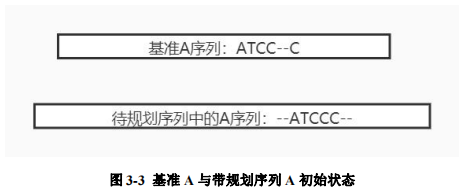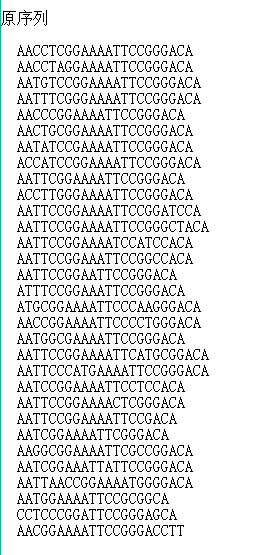|
生物信息学系列博客索引
生物信息学(1)——双序列比对之Needleman-Wunsch(NW)算法详解及C++实现 生物信息学(2)——双序列比对之Smith-Waterman(SW)算法详解 生物信息学(3)——双序列比对之BLAST算法简介 生物信息学(4)——多序列比对之CLUSTAL算法详解及C++实现 生物信息学(5)——基于CUDA的多序列比对并行算法的设计与代码实现 项目gitee地址,内附源码、论文等文档信息
1. CLUSTAL简介
CLUSTAL算法由 Feng 和 Doolittle等人于1987年提出,是一个渐进比对算法。渐进比对算法的基本思想是重复地利用双序列比对算法, 先由两个序列的比对开始, 逐渐添加新序列, 直到一个序列簇中的所有序列都加入为止。但是不同的添加顺序会产生不同的比对结果,因此, 确定合适的比对顺序是渐进比对算法的一个关键问题。而两个序列越相似,就越能获取到高的比对效果,因此, 整个序列的比对应该从最相似的两个序列开始。
2. CLUSTAL算法过程详解
2.1 两两比对
构建一个n×n(n为序列簇中序列数量)的矩阵,横坐标与纵坐标均为整个序列簇成员,然后将序列两两比对,即用双序列比对算法计算矩阵的右上三角区域,记录两序列比对的相似度与结果。本博客使用生物信息学(1)介绍的NW算法进行两两比对。设有五个序列ABCDE,则可以构建如下图的矩阵,两两比对,获取得分 
2.2 构建向导树
CLUSTAL算法是利用邻接法,根据矩阵构建向导树,而我将其简化成将矩阵的右上三角元素入队,然后 根据序列比对相似度排序,这样做更容易理解一些。 
2.3 渐近比对
根据向导树顺序或者队列出队顺序,逐步比对,比对规则为:如果序列 1 和 序列 2 均不在已经添加的序列当中,默认序列 1 与 A 序列进行比对,并调整, 序列 1 或 序列 2 在已经添加的序列之中,以在添加序列的序列为基准,进行调 整。
调整指的是已在最终多序列比对序列中的基准 A1 序列和待规划序列中的 A2 序列进行调整的过程。A1 与 A2 序列如下图 3-3,内容相同,中间会因为序 列比对产生的不规律的’-’符,目的是将两个序列通过添加补充’-’达到最简完全相 同。  
3. 运行结果
 
4. CLUSTAL算法C++实现
#include
#include
#include
#include
#include
#include
#include
#include
//声明命名空间std
using namespace std;
#define MATCH 1
#define DIS_MATCH -1
#define INDEL -3
#define INDEL_CHAR '-'
class ResUnit { //一次双序列比对后的结果
public:
string str1; //原始序列1
string str2; //原始序列2
string res1; //结果序列1
string res2; //结果序列2
int score; //序列总得分,反映两个序列的相似程度
int tag; //禁止迭代多次
};
class SingleSeq { //一个序列被整合后的样子
public:
string str; //一个序列的原始序列
string res; //一个序列被整合后的样子
};
struct BacktrackingUnit {
int goUp; //是否向上回溯
int goLeftUp; //是否向左上回溯
int goLeft; //是否向左回溯
int score; //得分矩阵第(i, j)这个单元的分值
};
typedef struct BacktrackingUnit *unitLine;
int max3(int a, int b, int c);
int myCompare(char a, char b);
ResUnit traceback(unitLine** item, const int i, const int j, string str1, string str2, string res1, string res2, int n, ResUnit resUnit);
ResUnit NeedlemanWunch(string str1, string str2);
void getResUnitMatrix(string *s, int length, ResUnit **res);
int ifStrInQueueFinish(string str, vector queue_finish);
vector RegularTwo(ResUnit tag, ResUnit temp, vector queue_finish);
vector RegularSeq1(ResUnit tag, vector queue_finish, int item);
vector RegularSeq2(ResUnit tag, vector queue_finish, int item);
struct SequenceUnit {
string *str1; //匹配序列1
string *str2; //匹配序列2
int score;
};
bool complare(const ResUnit &a, const ResUnit &b)
{
return a.score > b.score;
}
//主方法入口
int main() {
clock_t startTime, endTime;
startTime = clock();//计时开始
//clust算法
const int sequence_groups = 31;
string *ss = new string[sequence_groups];
ss[0] = "ACCTTGGGAAAATTCCGGGACA";
ss[1] = "AACGGAAAATTCCGGGACCTT";
ss[2] = "AATTCCGGAATTCCGGGACA";
ss[3] = "AATTCGGAAAATTCCGGGACA";
ss[4] = "AATTCCGGAAAATTCCGACA";
ss[5] = "AACCCGGAAAATTCCGGGACA";
ss[6] = "AATTCCGGAAAACTCGGGACA";
ss[7] = "AATGGAAAATTCCGCGGCA";
ss[8] = "AATGTCCGGAAAATTCCGGGACA";
ss[9] = "ATGCGGAAAATTCCCAAGGGACA";
ss[10] = "AATCGGAAATTATTCCGGGACA";
ss[11] = "CCTCCCGGATTCCGGGAGCA";
ss[12] = "AACTGCGGAAAATTCCGGGACA";
ss[13] = "AATTCCGGAAAATTCCGGATCCA";
ss[14] = "AATATCCGAAAATTCCGGGACA";
ss[15] = "AATTCCGGAAAATCCATCCACA";
ss[16] = "AATCGGAAAATTCGGGACA";
ss[17] = "AACCGGAAAATTCCCCTGGGACA";
ss[18] = "ATTTCCGGAAATTCCGGGACA";
ss[19] = "AATTCCGGAAATTCCGGCCACA";
ss[20] = "AAGGCGGAAAATTCGCCGGACA";
ss[21] = "AATGGCGAAAATTCCGGGACA";
ss[22] = "AATCCGGAAAATTCCTCCACA";
ss[23] = "AATTTCGGGAAAATTCCGGGACA";
ss[24] = "AATTCCGGAAAATTCCGGGCTACA";
ss[25] = "AACCTCGGAAAATTCCGGGACA";
ss[26] = "AATTAACCGGAAAATGGGGACA";
ss[27] = "ACCATCCGGAAAATTCCGGGACA";
ss[28] = "AATTCCGGAAAATTCATGCGGACA";
ss[29] = "AATTCCCATGAAAATTCCGGGACA";
ss[30] = "AACCTAGGAAAATTCCGGGACA";
vector queue_initial(0); //定义等待整合的队列,是一个ResUnit对象vector
vector queue_finish(0); //定义整合完毕的队列,是一个String类型的vector
vector::iterator it; //迭代器,访问queue_initial
vector::iterator it_finish; //迭代器,访问queue_finish
//结果矩阵,,二维向量
ResUnit **res;
res = new ResUnit*[sequence_groups];
for (int i = 0; i
res[i][j] = ResUnit();
}
}
getResUnitMatrix(ss, sequence_groups, res);
//开始多序列比对
//定义队列长度
int queue_length = ((sequence_groups - 1)*sequence_groups) / 2;
cout
//放入容器
queue_initial.push_back(res[i][j]);
}
}
//排序
sort(queue_initial.begin(), queue_initial.end(), complare);
//最多循环queue_length次
for (int i = 0;i
SingleSeq singleSeq1, singleSeq2;
singleSeq1.str = queue_initial.at(i).str1;
singleSeq1.res = queue_initial.at(i).res1;
singleSeq2.str = queue_initial.at(i).str2;
singleSeq2.res = queue_initial.at(i).res2;
//如果结果队列已经有元素,,且又来了俩不相干的,却很匹配的序列对
if (queue_finish.size()>0) {
//将结果队列第一个的序列和queue_initial.at(i).str1进行双序列比对
ResUnit temp = NeedlemanWunch(queue_finish.front().str, queue_initial.at(i).str1);
//进行规整操作
queue_finish = RegularTwo(queue_initial.at(i), temp, queue_finish);
}
else
{
queue_finish.push_back(singleSeq1);
queue_finish.push_back(singleSeq2);
}
}
//str1在,str2不在
else if (ifStrInQueueFinish(queue_initial.at(i).str1, queue_finish) > -1 && ifStrInQueueFinish(queue_initial.at(i).str2, queue_finish)
int item = ifStrInQueueFinish(queue_initial.at(i).str2, queue_finish);
queue_finish = RegularSeq2(queue_initial.at(i), queue_finish, item);
}
}
//声明一个迭代器,来访问vector容器
cout
cout
if (E2[i] == E1[j]) {
i++;
j++;
}
else {
if (E2[i] == '-') {
E1.insert(j, "-");
F.insert(j, "-");
}
else if (E1[j] == '-')
{
E2.insert(i, "-");
A2.insert(i, "-");
}
}
}
if (i == E2.length()) {
//E2先到头
for (int k = 0; k
//E1先到头
for (int k = 0; k
if (A1[i] == A2[j]) {
i++;
j++;
}
else {
if (A1[i] == '-') {
A2.insert(j, "-");
E1.insert(j, "-");
F.insert(j, "-");
}
else if (A2[j] == '-')
{
A1.insert(i, "-");
for (it = queue_finish.begin();it != queue_finish.end();it++) {
it->res = it->res.insert(i, "-");
}
}
}
}
if (i == A1.length()) {
//A1先到头
for (int k = 0; k
it->res = it->res + tempStr;
}
}
else if (j == A2.length()) {
//A2先到头
for (int k = 0; k
SingleSeq main_seq = queue_finish.at(item);//找到和seq1相同的序列
string A1 = main_seq.res;
string A2 = tag.res1;
string E = tag.res2;
string tempStr = "";
vector::iterator it;//声明一个迭代器,来访问vector容器
int i = 0, j = 0;
while (A1 != A2 && i
i++;
j++;
}
else {
if (A1[i] == '-') {
A2.insert(j, "-");
E.insert(j, "-");
}
else if (A2[j] == '-') {
//遍历queue_finish,给queue_finish内res洗头
A1.insert(i, "-");
for (it = queue_finish.begin();it != queue_finish.end();it++) {
it->res = it->res.insert(i, "-");
}
}
}
}
if (i == A1.length()) {
//A1先到头
for (int k = 0; k
it->res = it->res + tempStr;
}
}
else if (j == A2.length()) {
//A2先到头
for (int k = 0; k
SingleSeq main_seq = queue_finish.at(item);//找到和seq1相同的序列
string A1 = main_seq.res;
string A2 = tag.res2;
string E = tag.res1;
string tempStr = "";
vector::iterator it;//声明一个迭代器,来访问vector容器
int i = 0, j = 0;
while (A1 != A2 && i
i++;
j++;
}
else {
if (A1[i] == '-') {
A2.insert(j, "-");
E.insert(j, "-");
}
else if (A2[j] == '-') {
//遍历queue_finish,给queue_finish内res洗头
A1.insert(i, "-");
for (it = queue_finish.begin();it != queue_finish.end();it++) {
it->res = it->res.insert(i, "-");
}
}
}
}
if (i == A1.length()) {
//A1先到头
for (int k = 0; k
it->res = it->res + tempStr;
}
}
else if (j == A2.length()) {
//A2先到头
for (int k = 0; k
int i = 0;
vector::iterator it;//声明一个迭代器,来访问vector容器
for (it = queue_finish.begin();it != queue_finish.end();it++) {
if (str == it->str)
return i;
i++;
}
return -1;
}
/**
循环比较一组序列的值,返回一个ResUnit对象数组,二维,且是个倒三角形状
其中,s是一个字符串类型的数组,存储等待序列比对的一组数据
*/
void getResUnitMatrix(string *s, int length, ResUnit **res) {
int sLength = length;
cout
for (int j = i + 1;j
int temp = a > b ? a : b;
return temp > c ? temp : c;
}
/**
比较两个字符类型属于什么,match,dismatch,indel
*/
int myCompare(char a, char b) {
if (a == b)
return MATCH;
else if (a == ' ' || b == ' ')
return INDEL;
else
return DIS_MATCH;
}
ResUnit traceback(unitLine** item, const int i, const int j, string str1, string str2, string res1, string res2, int n, ResUnit resUnit) {
unitLine temp = item[i][j];
if (resUnit.tag != 1)
{
if (!(i || j)) { // 到矩阵单元(0, 0)才算结束,这代表初始的两个字符串的每个字符都被比对到了
resUnit.str1 = str1;
resUnit.str2 = str2;
resUnit.res1 = res1;
resUnit.res2 = res2;
resUnit.tag = 1;
return resUnit;
}
if (temp->goUp) { // 向上回溯一格
res1 = str1[i - 1] + res1;
res2 = INDEL_CHAR + res2;
resUnit = traceback(item, i - 1, j, str1, str2, res1, res2, n + 1, resUnit);
}
if (temp->goLeftUp) { // 向左上回溯一格
res1 = str1[i - 1] + res1;
res2 = str2[j - 1] + res2;
resUnit = traceback(item, i - 1, j - 1, str1, str2, res1, res2, n + 1, resUnit);
}
if (temp->goLeft) { // 向左回溯一格
res1 = INDEL_CHAR + res1;
res2 = str2[j - 1] + res2;
resUnit = traceback(item, i, j - 1, str1, str2, res1, res2, n + 1, resUnit);
}
return resUnit;
}
else
{
return resUnit;
}
}
ResUnit NeedlemanWunch(string str1, string str2) {
//字符串str1,str2长度
const int m = str1.length();
const int n = str2.length();
int m1, m2, m3, mm;
unitLine **unit;
// 初始化
if ((unit = (unitLine **)malloc(sizeof(unitLine*) * (m + 1))) == NULL) {
fputs("Error: Out of space!\n", stderr);
exit(1);
}
for (int i = 0; i
fputs("Error: Out of space!\n", stderr);
exit(1);
}
for (int j = 0; j
fputs("Error: Out of space!\n", stderr);
exit(1);
}
unit[i][j]->goUp = 0;
unit[i][j]->goLeftUp = 0;
unit[i][j]->goLeft = 0;
}
}
unit[0][0]->score = 0;
for (int i = 1; i
unit[0][j]->score = INDEL * j;
unit[0][j]->goLeft = 1;
}
// 动态规划算法计算得分矩阵每个单元的分值
for (int i = 1; i
m1 = unit[i - 1][j]->score + INDEL;
m2 = unit[i - 1][j - 1]->score + myCompare(str1[i - 1], str2[j - 1]);
m3 = unit[i][j - 1]->score + INDEL;
mm = max3(m1, m2, m3);
unit[i][j]->score = mm;
//判断路径来源
if (m1 == mm) unit[i][j]->goUp = 1;
if (m2 == mm) unit[i][j]->goLeftUp = 1;
if (m3 == mm) unit[i][j]->goLeft = 1;
}
}
//开始回溯
ResUnit res;
res.tag = 0;
res = traceback(unit, m, n, str1, str2, "", "", 0, res);
res.score = unit[m][n]->score;
//释放内存
for (int i = 0; i
free(unit[i][j]);
}
free(unit[i]);
}
free(unit);
//返回值
return res;
}
5. 总结
虽然CLUSTAL算法具有较高的精度,但是由于其构造导向树的距离,即两两比对的过程,需要迭代调用双序列比对算法,
这将使得算法的时间复杂度来到n的四次方,数据愈多,需要消耗的时间就指数增加,对CPU造成巨大压力。
下一篇将利用CUDA平台调度GPU提供的并行计算能力加速CLUSTAL执行速度。
如果有什么问题,请私信联系我或者在评论区留言 码字不易,若有帮助,给个关注和赞呗

|






